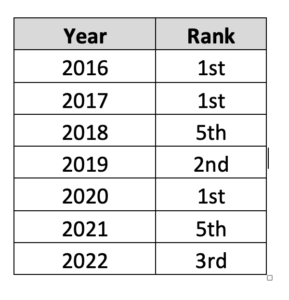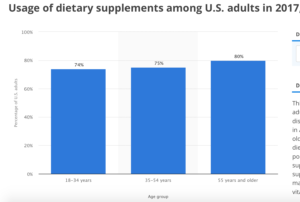Vitamins and minerals as food extracts have a long history dating back to the early 1900s when they were first identified. They have since been recognized for their potential to contribute to human health, although there is a divergence of thinking as to their exact potential and role.
This debate is almost mute in the sport and fitness industry, where the focus on these micronutrients has been overshadowed by the development and marketing of more supplements touted as ‘performance enhancement’ supplements.
In fact its fair to say that the humble vitamin has become so ‘boring’ or ‘old-world’ or ‘not sexy’ that potentially the majority of those taking supplements in this industry do not both to include them in their supplement regime.
Why have the majority in the sports and fitness industry eschewed the humble vitamin? One contributing factor could be that the lack of consensus and presence of debate surrounding the efficacy (and in the minds of some) and safety of this century old discovery. This has certainly made it easier for the so-called performance enhancement supplement manufacturers and marketers to promote their offering in an environment where the full vitamin story may not have been told.
The aim of this article is to contribute to and perhaps enhance your consideration towards vitamins. Perhaps if the extent of the role of the humble vitamin was more greatly appreciated, the average person influenced by the power of marketing may have more reason to return to the basics, or at least include these basics.
The journey of one vitamin – Vitamin C – will be used to give insights into and highlight the journey of vitamins. Vitamin C is also an excellent showcase as it is one that has received a lot of attention since Linus Pauling turned his (and the world’s) attention to it from the late 1960s.
The vitamin story origin
The vitamin story origin began back in the early 1900s. Casimir Funk, a Polish biochemist, is credited this origin, when in 1911 he published on the subject, using the words “vital amines” or “vitamines” to describe his discovery. In 1912 he published another article proposing :
“…the existence of at least four vitamins: one preventing beriberi (“antiberiberi”); one preventing scurvy (“antiscorbutic”); one preventing pellagra (“antipellagric”); and one preventing rickets (“antirachitic”) “[1]
Ironically Funk proposed the idea that various diseases could be cured with nutrients.[2] I say ironically because from the out-set the battle lines were drawn with an industry that was already in existence, and arguably felt threatened – the medical industry.
This cited quote from a 1922 Journal of the American Medical Association (JAMA) in relation to certain supplements:
“ The claims set forth on the labels of the medicinal values of these preparations are extravagant and misleading…”[3]
The Vitamin C story
Albert Szent-Gyorgyi, a Hungarian scientist and 1937 Nobel Peace Prize winner, is credited with discovering Vitamin C in the 1930s. Within a few years, vitamin C (ascorbic acid) became recognized as a substance that greatly improved one’s health.[4]
One prominent US scientist who took a great deal of interest in the vitamin discovery was Linus Pauling.
Linus Pauling has a very substantial resume. He is described as: [5]
“…an American chemist, biochemist, peace activist, author, educator, and husband of American human rights activist Ava Helen Pauling, Pauling published more than 1,200 papers and books, of which about 850 dealt with scientific topics. New Scientist called him one of the 20 greatest scientists of all time,[6] and as of 2000, he was rated the 16th most important scientist in history.[7]”
Along the way he won two Nobel Peace prize – unshared (1954 for Chemistry; and 1962 for Peace Activism) – making him only one of four individuals to have won two, one of only two to have won them in different fields, and the only person to have been awarded two unshared Nobel Peace Prizes. [8]
He then turned his attention to health, and concluded that:
“Optimal health could be achieved by perfecting reaction conditions and making sure that the body maintained the proper balance of chemicals–nutrients, catalysts, and products.“[9]
He coined the term ‘orthomolecular’, meaning the ‘right molecules in the right amounts, and used the term in conjunction with the word ‘medicine’.
He first used the term in print in 1967 in relation to psychiatric therapy. He had by then become convinced that conditions such as schizophrenia could be treated with nutrients such as niacin, an approach developed by Abram Hoffer and Humphrey Osmond. However, his theory of orthomolecular psychiatry was ignored or criticized by the medical community. [10]
Pauling became openly vocal specifically about vitamin C form about 1969, when he “was commenting to reporters that physicians should pay more attention to vitamin C”. [11]
Pauling took a much larger step when he became intrigued with the biochemistry of nutrition. This included exploring the possibility that mental retardation and mental illness (especially schizophrenia) were caused by various biochemical and genetic disorders. This later led to collaborative clinical research with Dr. Abram Hoffer on the therapeutic efficacy of vitamins in cancer.[12]
Pauling proposed that conditions such as:
“…mental abnormalities….. and cancer might be successfully treated by correcting imbalances or deficiencies among naturally occurring biochemical constituents, notably vitamins and other micronutrients, as an alternative to the administration of potent synthetic psychoactive drugs”. [13]
In 1976, Pauling and Dr. Ewan Cameron, a Scottish physician, reported that a majority of one hundred “terminal” cancer patients treated with 10,000 mg of vitamin C daily survived three to four times longer than similar patients who did not receive vitamin C supplement. This research was criticized by r. William DeWys, chief of clinical investigations at the National Cancer Institute, amongst others.[14]
They published their results between 1974 and 1978. [15] [16] [17] [18]
This is where he may have stepped over the line in the eyes of the medical and pharmaceutical industries. He was easy pickings as he was reaching into areas that many were to claim were not his ‘specialty’:
Many felt Pauling was too far out of his field of expertise with his research into nutrition, and he was largely ignored by mainstream medicine and nutritional science.[19]
I’m not sure that ‘ignored’ is the best way to describe the response. I suggest it was more active than that, as exemplified by the below comment:
Treating cancer with high-doses of vitamin C is a zombie idea that began with Linus Pauling, and has failed to die ever since. But has new research vindicated this idea? No. No in any meaningful way.[20]
The medical response to Vitamin C
At the time of Linus Pauling putting his credibility behind increased Vitamin C dosage, the US Recommended Dietary Allowance (RDA – RDAs were originally set in 1941)[21] and the figure in place at that time for Vitamin C was 60 mg/day for both adult men and women.[22] Which was the equivalent of the vitamin C in average orange.[23] In other words, it was expected that most people could get all the vitamins they needed from their diet, and to suggest supplementation was challenging to the mainstream belief.
In response to Pauling’s claims:
“Dr. Victor Herbert, a clinical nutritionist who had helped set the FDA’s recommended daily allowances for vitamins, wrote Pauling a letter demanding the evidence for recommending increased doses of vitamin C”.[24]
In return Pauling collated the literature and research on the health benefits of Vitamin C and in 1971 published a book titled ‘Vitamin C and the Common Cold’.
This contributed to a generation who began taking their daily Vitamin C tablet, as you may discover if you ask those alive during that decade.
Not everyone was happy however. This is one of the reviews to Paulings book, published in the Journal of American Medical Association.
“Unfortunately, many laymen are going to believe the ideas that the author is selling,” Franklin Bing wrote in a scathing review of the “irritating” book in the Journal of the American Medical Association.[25]
In his 1971 book Pauling recommended 1,000 mg of vitamin C daily, claiming it will reduce the incidence of colds by 45% for most people but that some people need much larger amounts. In his 1976 revision of the book he suggested even higher dosages, and in third book, Vitamin C and Cancer (1979) he claimed that high doses of vitamin C may be effective against cancer.
In How to Feel Better and Live Longer (1986) Pauling claimed that megadoses of vitamins
“….can improve your general health . . . to increase your enjoyment of life and can help in controlling heart disease, cancer, and other diseases and in slowing down the process of aging.”[26]
By 1991 he was recommending daily doses of 6,000 to 18,000 mg of vitamin C, 400 to 1,600 IU of vitamin E, and 25,000 IU of vitamin A, plus various other vitamins and minerals.
In a 1984 US court case,[27] Pauling testified that the proper intake of vitamin C for adults was “around 10 or 20 grams per day,” that this would significantly reduce death rates, and that he knew of people who had taken 150 grams of vitamin C daily for years without serious side effects:
I have taken 50,000 milligrams a day for several days in succession without having any serious side effect, and I know people who have taken a hundred and fifty thousand milligrams, a third of a pound a day, day after day for years without any serious side effects. [28]
Within a year of Pauling’s 1978 research into the cancer benefits of Vitamin C, research results from a Mayo Clinic trial that apparently ‘proved’ Pauling’s conclusions were mistaken[29] [30] and he was generally criticized for ‘flawed research’. [31]As to the accuracy of these claims I will allow you to reach your own conclusions.
You can also reach your own conclusions about two very different ‘research conclusions’ as to the role of Vitamin C in cancer treatment. Some suggest their were less than desirable motives behind the Mayo study results.[32]
Meanwhile, the RDA for Vitamin C was upgraded in 2000 from 60 mg for both adult men and women to 75 mg/day for adult women and 90mg/day for adult men.[33] Some variation was provided for different conditions, and for the first time an ‘upper safe limit’ was given, at 2,000 mg/day.

So there is movement in the mainstream, medical industry influenced recommendations, however the gap remains huge between what the likes of Linus Pauling and others concluded some half a century ago, and what we are ‘allowed’ to consume.
So what were leading strength training expert saying during the decade where Pauling and his associates were producing their studies? In the late 1970s, in his book, The Strongest Shall Survive,[34] Bill Starr suggested the strength training athlete consume 4,000 mg/day of Vitamin C.
A significant breakthrough in the medical community occurred when in 2002 in a Journal of American Medical Association (JAMA) article, vitamin supplementation was embraced for arguably the first time, even if it was at a lower level.
Most people do not consume an optimal amount of all vitamins by diet alone. Pending strong evidence of effectiveness from randomized trials, it appears prudent for all adults to take vitamin supplements. The evidence base for tailoring the contents of multivitamins to specific characteristics of patients such as age, sex, and physical activity and for testing vitamin levels to guide specific supplementation practices is limited. Physicians should make specific efforts to learn about their patients’ use of vitamins to ensure that they are taking vitamins they should…. avoiding dangerous practices….[35]
Even so, fifteen years later, the medical embrace of Vitamins such as Vitamin C is lukewarm at best:
The data show that vitamin C is only marginally beneficial when it comes to the common cold,” says Dr. Bruce Bistrian, chief of clinical nutrition at Harvard-affiliated Beth Israel Deaconess Medical Center.[36]
What if?
So what if vitamins had the potential to do more than reduce the time frame for a common cold, or enhance general health? What if it could do the things that Linus Pauling; Canadian biochemist, physician, and psychiatrist Abram Hofer;[37] [38] and others (including more recently the likes of Andrew Saul)claim they can do?
What if, for example, the story of the New Zealand farmer who recovered from near death through intravenous Vitamin C administration is true?[39] What if this case has broader application?
The challenge with this latter case is that it was published in a very mainstream Australian TV program, a serious break from tradition in what could reasonably be described as a bow for the anti-vitamin advocates and industry.
Here’s the major stumbling block – nutritional supplement labels cannot make disease related claims.
Developed country nutritional supplement manufacturers can only make certain claims. For example in the US claims on the label must meet one of three criteria, as determined by the relevant government regulator, the Food and Drug Administration (FDA):[40]
1) the 1990 Nutrition Labeling and Education Act (NLEA) provides for FDA to issue regulations authorizing health claims for foods and dietary supplements after reviewing and evaluating the scientific evidence, either in response to a health claim petition or on its own initiative;
2) the 1997 Food and Drug Administration Modernization Act (FDAMA) provides for health claims based on an authoritative statement of the National Academy of Sciences or a scientific body of the U.S. government with responsibility for public health protection or nutrition research; such claims may be used 120 days after a health claim notification has been submitted to FDA, unless the agency has informed the notifier that the notification does not include all the required information; and
3) as described in FDA’s guidance entitled Interim Procedures for Qualified Health Claims in the Labeling of Conventional Human Food and Human Dietary Supplements, the agency reviews petitions for qualified health claims where the quality and strength of the scientific evidence falls below that required for FDA to issue an authorizing regulation.
In essence, until the medical and scientific community is willing to embrace that nutritional supplements have more of a role to play via supplementation than ‘general health’, there is little chance that the broader society will learn about any such additional benefits.
At this stage the FDA accepts some general health benefits of nutritional supplements, but nothing more:[41]
Scientific evidence shows that some dietary supplements are beneficial for overall health and for managing some health conditions. For example, calcium and vitamin D are important for keeping bones strong and reducing bone loss; folic acid decreases the risk of certain birth defects; and omega-3 fatty acids from fish oils might help some people with heart disease. Other supplements need more study to determine their value. The U.S. Food and Drug Administration (FDA) does not determine whether dietary supplements are effective before they are marketed.
Until this changes – and it’s been this way for over half a century – you will only find a diluted ‘general’ comment about nutritional supplements in relation to their role in dealing with more serous health issues.
…if you start to look at supplement labels or brochures you’ll find diseases are not mentioned. Instead of finding supplements labeled for arthritis or high blood pressure, the labels say things like “helps maintain healthy joint movement” or “supports blood pressure levels in the normal range.[42]
This has been a point of frustration in the bodybuilding and fitness industry since as early as the 1950s in the US, where the enforcement action taken by the FDA against all the major supplement industry players (Weider, Hoffman, Johnson, and Rader, in relation to his labeling claims.[43]
If you want to hear more about or from those who belief that nutritional supplements have the ability to fulfill the things that Pauling, Hofer and others spoke about, you won’t get that information from manufacturers. But you will get that information from sources that are not regulated by government agencies.
Here are a few resources you might want to check out if you are interested in this area:
These are just a few of the growing global discussion on the role of supplementation in matters relating to larger health issues.
A question worth asking for those who are not currently facing serious medical issues and who are committed to optimal health – if certain nutritional supplements (e.g. Vitamin C) in specific dosages (i.e. what are considered above the RDA upper limit of 2,000mg/day) – do have the potential or ability to positive impact the more serious health conditions, what could they do for the health of others?
I will leave you to determine if that is a question you have.
Conclusion
So who do you believe when it comes to your health and vitamins and minerals? Or vitamins and minerals vs. drugs for your health? This is your decision. What I have done in the above article is to give you some insights into the history of vitamins and minerals,and sought to broaden your awareness about the claims and history of the claims as they relate to vitamins and serious health conditions.
On one hand you have incredibly smart people such as Linus Pauling (even though some found it appropriate to label him a quack[44]) making significant claims about the health benefits of vitamins, yet on the other hand you have some saying they are either useless[45] or actually cause disease[46].
There is a lot of talk on the internet about whether Linus Pauling has been vindicated. Here are titles from just the first page of a Google search ‘has Linus Pauling been vindicated’:
- Linus Pauling Vitamin C Theory Vindicated? [47]
- Linus Pauling May Have Been Vindicated – Vitamin C May Treat Cancer[48]
- A vindication of Linus Pauling’s bizarre theory that vitamin C prevents cancer? [49]
- High dose vitamin C and cancer: Has Linus Pauling been vindicated[50]
- Vitamin C, Linus Pauling was right all along. A doctor’s opinion[51]
- Linus Pauling vindicated – International Health News[52]
- Vindication For Linus Pauling | Life Extension Magazine[53]
- Linus Pauling Vindicated; Researchers Claim RDA for Vitamin C is Flawed[54]
It’s been over 50 years since Linus spoke out about the benefits of high dose vitamins. If he was on track, there’s been more than one generation of humans potentially denied the benefits due to the lack of clarity on the subject. Are you going to be one of them? It may be time to do your own research, including personal experiments to reach your own conclusions.
References
[1] https://en.wikipedia.org/wiki/Casimir_Funk
[2] https://amazingwellnessmag.com/features/history-of-vitamins
[3] https://en.wikipedia.org/wiki/Casimir_Funk
[4] https://paulingblog.wordpress.com/2011/06/15/casimir-funk-and-a-century-of-vitamins/
[5] https://en.wikipedia.org/wiki/Linus_Pauling#cite_note-Horgan-6
[6] Horgan, J (1993). “Profile: Linus C. Pauling – Stubbornly Ahead of His Time”. Scientific American. 266 (3): 36–40. Bibcode:1993SciAm.266c..36H. doi:10.1038/scientificamerican0393-36.
[7] Gribbin, J (2002). The Scientists: A History of Science Told Through the Lives of Its Greatest Inventors. New York: Random House. pp. 558–569. ISBN 0812967887.
[8] https://en.wikipedia.org/wiki/Linus_Pauling#cite_note-Horgan-6
[9] https://profiles.nlm.nih.gov/ps/retrieve/Narrative/MM/p-nid/57
[10] https://profiles.nlm.nih.gov/ps/retrieve/Narrative/MM/p-nid/57
[11] https://profiles.nlm.nih.gov/ps/retrieve/Narrative/MM/p-nid/57
[12] http://lpi.oregonstate.edu/about/linus-pauling-biography
[13] http://lpi.oregonstate.edu/about/linus-pauling-biography
[14] https://www.quackwatch.org/01QuackeryRelatedTopics/pauling.html
[15] Cameron E, Campbell A. The orthomolecular treatment of cancer. II. Clinical trial of high-dose ascorbic acid supplements in advanced human cancer. Chem Biol Interact 1974;9:285-315
[16] Cameron E, Campbell A, Jack T. The orthomolecular treatment of cancer. III. Reticulum cell sarcoma: double complete regression induced by high-dose ascorbic acid therapy. Chem Biol Interact 1975;11:387-93.
[17] Cameron E, Pauling L. Supplemental ascorbate in the supportive treatment of cancer: prolongation of survival times in terminal human cancer. Proc Natl Acad Sci U S A 1976;73:3685-9.
[18] Cameron E, Pauling L. Supplemental ascorbate in the supportive treatment of cancer: reevaluation of prolongation of survival times in terminal human cancer. Proc Natl Acad Sci U S A 1978;75:4538-42.
[19] https://articles.mercola.com/sites/articles/archive/2015/11/23/vitamin-c-curative-power.aspx
[20] https://sciencebasedmedicine.org/high-dose-vitamin-c-and-cancer-has-linus-pauling-been-vindicated/
[21] https://en.wikipedia.org/wiki/Dietary_Reference_Intake
[22] http://www.pnas.org/content/pnas/93/25/14344.full.pdf
[23] http://healthyeating.sfgate.com/many-mgs-vitamin-c-medium-oranges-6455.html
[24] https://profiles.nlm.nih.gov/ps/retrieve/Narrative/MM/p-nid/57
[25] https://www.vox.com/2015/1/15/7547741/vitamin-c-myth-pauling
[26] http://osupress.oregonstate.edu/book/how-to-live-longer-and-feel-better
[27] Pauling L Testimony at a hearing concerning Michael Gerber, M.D., March 6, 1984
[28] https://www.casewatch.org/board/med/gerber/pauling_1984.pdf
[29] Creagan ET, Moertel CG, O’Fallon JR, et al. Failure of high-dose vitamin C (ascorbic acid) therapy to benefit patients with advanced cancer. A controlled trial. N Engl J Med 1979;301:687-90.
[30] Moertel CG, Fleming TR, Creagan ET, et al. High-dose vitamin C versus placebo in the treatment of patients with advanced cancer who have had no prior chemotherapy. A randomized double-blind comparison. N Engl J Med 1985;312:137-41.
[31] https://www.ncbi.nlm.nih.gov/pmc/articles/PMC1405876/
[32] https://www.cancertutor.com/war_pauling/
[33] http://lpi.oregonstate.edu/mic/vitamins/vitamin-C
[34] https://www.amazon.com/Strongest-Shall-Survive-Strength-Training/dp/B000GK2BLU
[35] https://www.ncbi.nlm.nih.gov/pubmed/12069676
[36] https://www.health.harvard.edu/cold-and-flu/can-vitamin-c-prevent-a-cold
[37] https://en.wikipedia.org/wiki/Abram_Hoffer
[38] http://orthomolecular.org/history/hoffer/index.shtml
[39] https://www.foodmatters.com/article/nz-farmer-beats-swine-flu-with-vitamin-c-60-minutes-report
[40] https://www.fda.gov/Food/LabelingNutrition/ucm111447.htm
[41] https://ods.od.nih.gov/HealthInformation/DS_WhatYouNeedToKnow.aspx
[42] https://www.nowfoods.com/now/nowledge/why-dont-supplement-labels-talk-about-disease
[43] Roach, R., 2008, Muscle, Smoke and Mirrors, Vol. 1, Author House, p. 208.
[44] https://www.quackwatch.org/01QuackeryRelatedTopics/pauling.html
[45] https://www.businessinsider.com.au/what-vitamins-should-i-take-2015-10?r=US&IR=T
[46] http://www.dailymail.co.uk/health/article-184617/Vitamins-increase-risk-heart-disease.html
[47] https://newsblaze.com/issues/science/linus-pauling-vitamin-c-theory-vindicated_40227/
[48] https://raypeatforum.com/community/threads/linus-pauling-may-have-been-vindicated-vitamin-c-may-treat-cancer.14891/
[49] http://edzardernst.com/2014/08/a-vindication-of-linus-paulings-bizarre-theory-that-vitamin-c-prevents-cancer/
[50] https://sciencebasedmedicine.org/high-dose-vitamin-c-and-cancer-has-linus-pauling-been-vindicated/
[51] 8https://www.google.com/search?client=safari&rls=en&q=has+linus+pauling+been+vindicated&ie=UTF-8&oe=UTF-8
[52] https://www.google.com/search?client=safari&rls=en&q=has+linus+pauling+been+vindicated&ie=UTF-8&oe=UTF-8
[53] https://www.google.com/search?client=safari&rls=en&q=has+linus+pauling+been+vindicated&ie=UTF-8&oe=UTF-8
[54] http://www.laleva.org/eng/2004/07/linus_pauling_vindicated_researchers_claim_rda_for_vitamin_c_is_flawed.html














